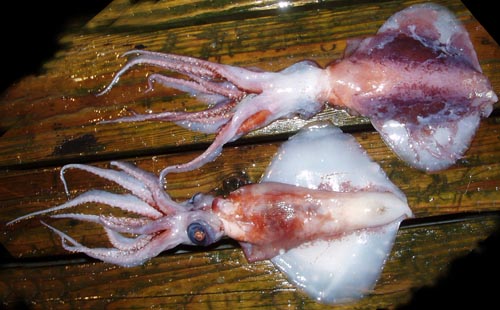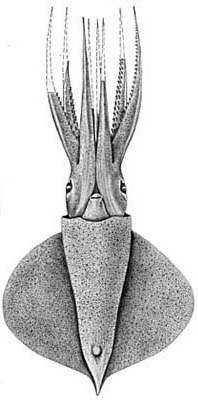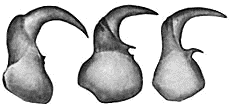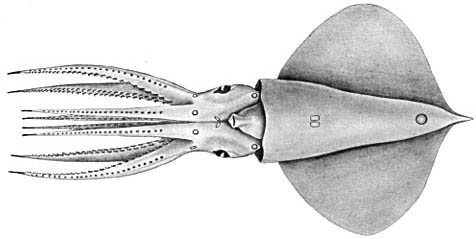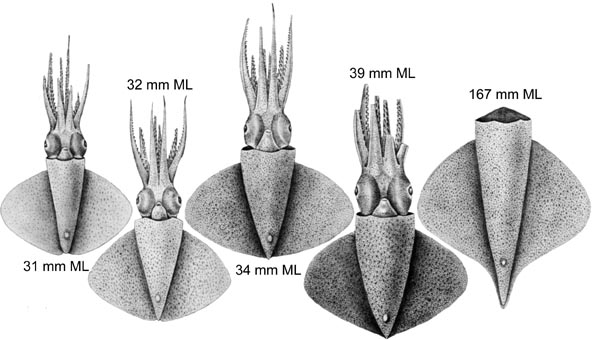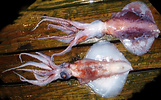Octopoteuthis deletron
Richard E. YoungIntroduction
This species is easily separated from the only other north Pacific species (O. nielseni) by the presence of one rather than two large tail photophores.
Diagnosis
A Octopoteuthis ...
- with a single tail photophore.
- with a temperate Pacific Ocean habitat.
Characteristics
- Arms
- Hooks with accessory cusps that become more prominent with size.
Figure. Side view of large arm III hooks of O. deletron. Left - Ca. 20 mm ML. Middle - 109 mm ML. Right - 167 mm ML.
- 3-12 pairs of small suckers near arm tips, each with 6-9 irregular, pointed teeth.
Figure. Left - Oral view of arm III tip of O. deletron, 167 mm ML. Right - Oral view of inner sucker ring from the same arm tip, 5th transverse row from hooks.
- Hooks with accessory cusps that become more prominent with size.
- Tentacles
- Absent by 15-25 mm ML.
- Photophores
- Single "tail" photophore.
- Arm organs: series of ca 25 organs near core of each arm III and IV; basal photophore larger and somewhat isolated, on arms II-IV.
- Ventral head organs: one, large, posterior to each eye; elongate, oblique organ near anteromedial margin of each eye.
- Visceral organs: pair near ventral surface of ink sac beneath muscle bands.
Figure. Ventral view of O. deletron, holotype, 109 mm ML, showing photophore pattern.
Comments
Most photophores are embedded in tissue and are difficult to see.Life History
Strong developmental changes occur between ca. 30-40 mm ML that include large changes in eye size, thickness of arms and body, and increases in pigmentation. This is, presumably the transition from the juvenile to the subadult stage. Squid of nearly the same size at this critical stage, therefore, can look like different species. In large specimens, the tail becomes prominent.
Figure. Ventral views of O. deletron. Left - Four drawings show the marked changes that occur between 30-40 mm ML. Right - The mantle and fins of a large squid showing the distinct tail at this size.
Mature males lack a hectocotylus but have a large penis that, apparently, can extend well beyond the mantle opening. Mature eggs are about 2 mm in diameter (Young, 1972). Paralarvae have not been described.
Distribution
Type locality: Eastern North Pacific at 33°15'N, 118°37'W (off Southern California). This species is found from off Baja California to Alaska, off Northern Peru and possibly off Eastern Honshu (Nesis, 1982/87).
References
Nesis, K. N. 1982/87. Abridged key to the cephalopod mollusks of the world's ocean. 385+ii pp. Light and Food Industry Publishing House, Moscow. (In Russian.). Translated into English by B. S. Levitov, ed. by L. A. Burgess (1987), Cephalopods of the world. T. F. H. Publications, Neptune City, NJ, 351pp.
Young, R. E. 1972. The systematics and areal distribution of pelagic cephalopods from the seas off Southern California. Smithson. Contr. Zool., 97: 1-159.
Title Illustrations
| Scientific Name | Octopoteuthis deletron |
|---|---|
| Location | Off Juneau, Alaska |
| Identified By | Elaina Jorgensen |
| View | Dorsal, ventral |
| Size | 240 mm ML |
| Copyright | © 2005 |
| Scientific Name | Octopoteuthis deletron |
|---|---|
| Location | Off Southern California |
| Reference | Young, R. E. 1972. The systematics and areal distribution of pelagic cephalopods from the seas off Southern California. Smithson. Contr. Zool., 97: 1-159. |
| Sex | Male |
| View | ventral |
| Size | 109 mm ML |
| Type | Holotype |
| Copyright | © 2005 Richard E. Young |
About This Page
Richard E. Young
Dept of Oceanography
University of Hawaii
Honolulu, Hawaii 96822
USA
Page copyright © 1999 Richard E. Young
Citing this page:
Young, Richard E. 1999. Octopoteuthis deletron . Version 01 January 1999 (complete). http://tolweb.org/Octopoteuthis_deletron/19843/1999.01.01 in The Tree of Life Web Project, http://tolweb.org/






